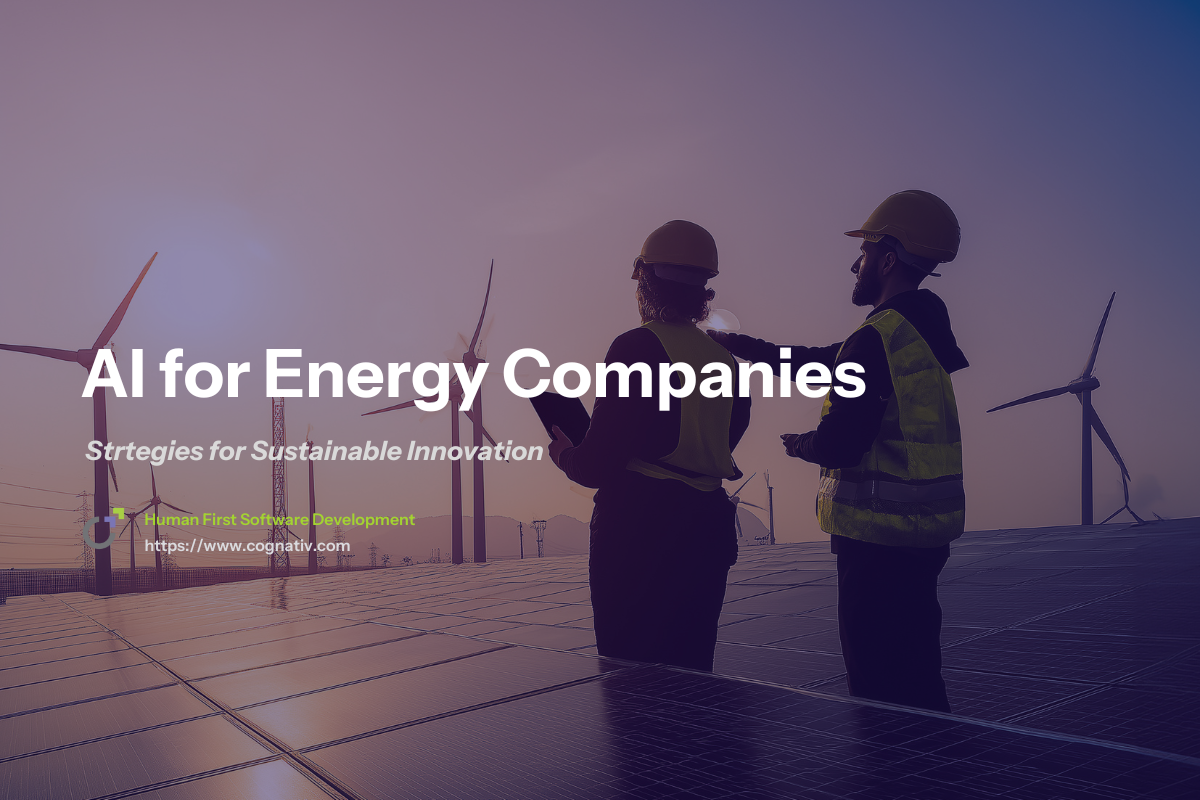Essential AI for Energy Companies: Strategies for a Sustainable Future
AI has moved from pilot projects to core infrastructure in the energy sector. AI plays a critical role in advancing safety, efficiency, and innovation in the energy industry.
Forward-leaning energy companies now use artificial intelligence to forecast energy demand, optimize dispatch, orchestrate energy storage, improve grid reliability, and reduce energy consumption—all while accelerating the transition to renewable energy. AI is enabling energy companies to be more efficient, adaptive, and sustainable, particularly by using advanced analytics and automation to enhance efficiency in operations.
The prize is twofold: measurable energy efficiency and resilient, lower-carbon operations that scale. AI also has a vital role in decarbonization and energy transformation, supporting sustainability goals and emissions reduction.

AI for Energy Companies: Why It Matters Now?
Modern grids operate under tighter constraints: intermittent solar and wind power, volatile fuel prices, electrification of transport and heat, and increasingly complex markets.
AI helps reconcile these pressures by turning vast amounts of telemetry, market signals, and weather data into actionable control decisions. AI algorithms optimize renewable energy forecasting, energy storage, and smart grid management by analyzing weather patterns, demand, and grid conditions to improve efficiency and reliability.
By analyzing weather patterns, AI enhances forecasting accuracy and grid management, leading to better operational decisions.
Higher energy efficiency across generation, transmission, and load, as AI is used to analyze data for improved reliability and operational efficiency.
Lower operating and maintenance costs via early warning on equipment failures, with AI-driven analysis of operational data.
Stronger grid stability and customer experience with real-time decisions, as AI helps predict and manage electricity usage to reduce peak demand and improve grid stability.
Faster progress toward net zero emissions through better renewable energy integration, supported by AI algorithms that analyze data and weather patterns for optimal performance.

Business Benefits: From Efficiency to Advantage
AI is transforming the energy landscape, offering innovative solutions that drive efficiency, sustainability, and resilience across the sector.
1) Operational Efficiency and Cost Reduction
AI tools and models are used to improve process efficiency and reduce waste in operations by reducing start-stop cycling, fuel burn, and energy waste while streamlining field work. In plants and networks, AI tools and predictive models help reduce waste by identifying and eliminating inefficiencies, prioritize interventions, cut maintenance costs, and shorten outages—raising asset utilization.
2) Real-Time Balancing and Customer Value
AI solutions forecast energy demand, price, and congestion; they balance supply and load in minutes-to-seconds intervals, keeping voltage and frequency within bounds. The result is fewer curtailments and better service quality for energy providers.
3) Sustainability at Lower Cost
By improving forecast accuracy for renewable energy sources and dispatching energy storage precisely, AI reduces curtailment and emissions. This directly supports corporate climate plans and regulatory obligations on carbon emissions, while also helping to reduce reliance on fossil fuels by increasing the efficiency and output of renewable energy sources.

AI Solutions for the Energy Industry
The energy sector is rapidly adopting AI technologies to tackle complex challenges and unlock new efficiencies across generation, distribution, and consumption. Here are some key AI applications transforming the industry.
Predictive Maintenance (Generation, Networks, Storage)
What it solves: Unplanned downtime, costly truck rolls, safety risk. Predictive maintenance is especially critical in the nuclear energy and gas industry sectors, where ensuring safety and operational efficiency is paramount.
**How it works:**AI technologies process vibration, infrared, and SCADA streams to detect anomalies days or weeks before failure.
Payoff: Fewer forced outages, safer operations, and optimized spares—core to improving grid reliability.
Smart Grid Management and DER Orchestration
What it solves: Variability from rooftop PV, EV charging, and flexible loads.
How it works: AI forecasts feeder-level load and DER output, then coordinates switching, voltage regulation, and energy storage dispatch, supporting grid integration and energy management by optimizing resource allocation and improving grid stability.
Payoff: Localized constraint relief, higher DER hosting capacity, better energy systems stability.
AI-Driven Energy Trading and Market Optimization
What it solves: Thin margins and volatile intraday markets.
How it works: ML models assimilate weather, grid operations, outages, and bids to optimize offer curves and hedges.
Payoff: Improved P&L while aligning with compliance constraints in energy trading. Industry leaders are leveraging AI to drive innovation and establish best practices in energy trading and market optimization.
Process & Industrial Efficiency (Behind the Meter)
What it solves: Inefficient industrial processes and high electricity consumption.
How it works: AI agents tune setpoints, heat integration, and batch schedules; computer vision validates quality.
Payoff: Lower energy consumption, fewer defects, reduced operational efficiency losses.

Data Foundations: What Great Looks Like
To scale ai energy capabilities, leaders invest in a durable data backbone:
Unified data model spanning assets, markets, work management, and customer systems.
High-resolution time-series storage for sensors and PMU/AMI streams.
Weather forecasts and reanalysis data fused with topology and constraints.
Privacy and OT security controls for sensitive data and mission-critical environments.
With this foundation, energy companies can deploy AI solutions once and reuse components across geographies and business lines.
Priority Use Cases (12–18 Month Roadmap)
Short-Term Load & Renewable Forecasting
-
Blend historical data, market trends, satellite/cloud cover, and on-site sensors to forecast energy demand and PV/wind output, optimizing renewable energy generation and supporting renewable energy projects.
KPI: MAPE reduction → fewer reserves and lower imbalance charges, while improving energy generation efficiency.
Storage Optimization & Charging Strategy
-
AI schedules batteries to arbitrage price, absorb curtailment, and deliver frequency response, helping to store energy and manage excess energy from renewable sources.
KPI: Increased storage revenue and improved grid reliability during peaks.
Condition-Based Maintenance
-
Prioritize work orders from anomaly detection on turbines, inverters, breakers, and transformers.
KPI: MTBF↑, SAIDI/SAIFI↓, reduce costs on crews and spares.
Loss Detection and Non-Technical Loss Analytics
-
Identify theft and metering anomalies; target inspections effectively.
KPI: Technical + non-technical loss reduction; payback < 12 months.
Market Bidding & Hedging Intelligence
-
Reinforcement learning augments trader playbooks within risk limits.
KPI: Sharpe ratio and realized spread improvements in energy trading.
Generative AI has the potential to drive innovation, accelerate renewable energy integration, and help overcome implementation challenges in the energy sector.

Implementation Playbook: From Pilot to Platform
Successfully scaling AI in the energy sector requires a clear, structured approach that aligns technology with business goals and operational realities.
1) Align Strategy to Value Pools
Tie each use case to measurable targets: curtailment reduction, fuel savings, reserve cost, or outage minutes. Ensure AI serves the enterprise climate plan and revenue mix.
2) Build the Target-State Architecture
Streaming ingestion and feature store (operational + real time data).
Model registry and CI/CD for ai solutions across plants and the grid.
Control-room integration and work-management hooks for closing the loop.
3) Operate with Responsible AI (RAI)
-
Document model limits; enforce human oversight for high-impact actions.
Bias testing for tariff/policy impacts; transparent explanations for regulators.
Cyber-hardening for OT/IT, including role-based access and anomaly detection.
4) Scale with Reuse
Modularize forecasting, optimization, and diagnostics so energy companies can lift-and-shift capabilities between wind, solar, thermal, and T&D—cutting time-to-value.

Measuring Impact: Metrics that Matter
Energy efficiency / heat rate (generation) and feeder loss factors (T&D)
Renewable energy utilization and curtailment avoided
Grid stability indices: frequency excursions, voltage violations
Predictive maintenance lead time and avoided outages
Energy storage round-trip value and degradation cost per cycle
Carbon emissions per MWh and progress toward sustainable future targets

Case Patterns by Segment
Utility-Scale Renewables: Sub-hourly wind/PV forecast + energy storage co-optimization increases revenue capture and reduces energy waste.
Retail Suppliers / ESCOs: Personalized demand models and DR automation optimize energy consumption at the meter while boosting engagement.
Networks (DSO/TSO): Feeder-level AI for switching plans, congestion relief, and smart grid management to manage smart grids with higher DER penetration.
Industrial Sites: Prescriptive controls deliver double-digit savings in thermal systems and compressed air while stabilizing energy production.

Governance and Risk
AI at grid scale requires disciplined controls:
Data governance: lineage, quality SLAs, and model audit trails.
Safety envelopes: AI proposes; operators approve for critical switching or dispatch.
Regulatory readiness: transparent models for planning and settlement, and explainability for market monitors.
Security: OT segmentation, continuous monitoring, and tested incident response.

Cybersecurity in the Age of AI: Protecting the Digital Energy Enterprise
As artificial intelligence becomes deeply embedded in the energy sector, cybersecurity has emerged as a critical priority for energy companies. AI systems now analyze vast amounts of operational and market data to optimize energy consumption, forecast energy demand, and improve energy efficiency. However, this digital transformation also expands the attack surface, exposing sensitive infrastructure to new risks such as data breaches, equipment failures, and potential grid disruptions.
To safeguard their digital assets, energy companies must implement robust cybersecurity strategies. This includes deploying advanced encryption, firewalls, and intrusion detection systems to protect both data and operational technology. Additionally, leveraging AI-powered cybersecurity tools enables real-time threat detection and rapid response, helping to maintain the reliability and resilience of the energy grid. By proactively addressing these challenges, energy companies can ensure that their investments in AI deliver value without compromising security or operational integrity.

Investing in AI: Building the Business Case for Energy Companies
For energy companies, investing in AI is no longer optional—it’s a strategic imperative for improving energy efficiency, reducing costs, and staying competitive in a rapidly changing market. The business case for AI starts with identifying high-impact opportunities: optimizing energy production, predicting equipment failures before they cause costly downtime, and streamlining industrial processes to reduce energy waste.
AI solutions empower energy companies to enhance operational efficiency, improve grid reliability, and balance supply and demand with greater precision. By integrating renewable energy sources like solar and wind power into the grid, AI helps manage variability and supports the broader energy transition. These capabilities not only reduce costs and energy waste but also position companies to capitalize on new revenue streams and regulatory incentives tied to sustainability.
Ultimately, investing in AI enables energy companies to unlock growth, strengthen their market position, and contribute to a more sustainable future. By focusing on measurable outcomes—such as improved energy efficiency, reduced maintenance costs, and better integration of renewables—energy leaders can build a compelling case for AI adoption that delivers both immediate and long-term value.

AI Leaders: Top Energy Companies Setting the Pace
Across the energy sector, a select group of companies are leading the way in AI adoption, setting new standards for innovation and operational excellence. Industry giants like Siemens Energy, General Electric, Shell, and Amazon are at the forefront, investing in advanced AI technologies to optimize energy consumption, forecast energy demand, and enhance smart grid management.
These AI leaders are leveraging predictive maintenance to minimize downtime, deploying AI-driven solutions for energy trading, and improving grid resilience in the face of evolving challenges. By collaborating with startups and research institutions, they are continuously exploring new applications of AI to stay ahead in a rapidly evolving energy landscape.
Their commitment to AI not only drives operational efficiency and supports the transition to net zero emissions, but also positions them as vital players in shaping the future of the energy industry. As the sector continues to embrace digital transformation, these companies exemplify how integrating AI technologies can deliver lasting value, improve grid resilience, and accelerate progress toward a more sustainable and efficient energy future.

The Strategic Outlook
The energy industry is rapidly evolving toward flexible, data-driven operations. AI solutions that forecast energy demand, integrate renewable energy sources, and steer energy trading will define winners. For energy companies, the mandate is clear:
Industrialize the data and model platform.
Prioritize high-value use cases first; expand through reuse.
Embed RAI and cybersecurity by design.
Tie outcomes to energy efficiency, reliability, and clean energy KPIs.
With the right foundation, ai for energy companies becomes a durable advantage—delivering lower cost, lower carbon, and a more resilient grid for a sustainable future.


